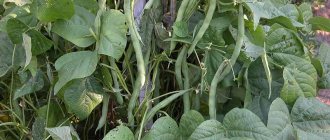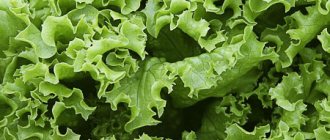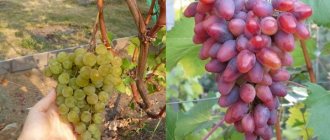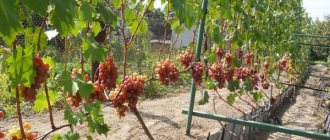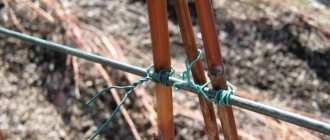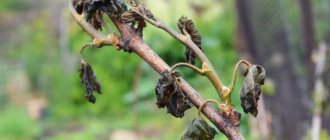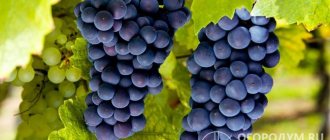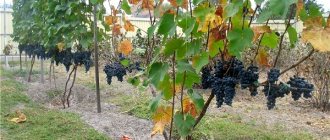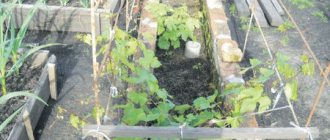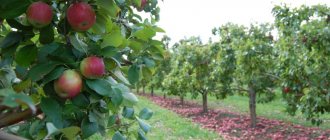Garden grapes prefer sunlight and warmth, so most varieties show high yields in warm regions. However, a number of varieties bear fruit well in harsh climatic conditions - in Altai and Siberia. According to the ripening period, grapes are divided into early, middle and late; by color - dark and white; by purpose - technical and canteen. When choosing grapes, pay attention to early ripening, self-fertility, frost resistance, and immunity. We will tell you in the article what grape varieties summer residents choose for Siberia and Altai.
Requirements for grape varieties for Siberia and Altai
For Siberia and the Altai Territory, they choose unpretentious and frost-resistant grape varieties that quickly adapt to the climatic conditions of the regions. Recommended frost resistance - up to -30°C. They also pay attention to the plant’s immunity - in order to get a rich harvest, grapes must be resistant to powdery mildew, oidium, anthracnose, and mildew. Varieties with weak immunity and low frost resistance will not take root in Altai or Siberia.
Sowing rules
Grapes in Siberia for beginners: planting and care
It is not easy to obtain grapes in Altai; for beginning gardeners it will be a big and difficult challenge. It is worth adhering to the basic rules of agricultural technology.
Grapes in Altai are planted in early April or May. Frost-resistant varieties should also be planted in October. And for them they make a special spruce branches for insulation.
How is spruce branches made? First, a trench 6-7 m long is dug, and the walls are reinforced with boards. The holes for digging cuttings should have a depth of at least 50 cm. Superphosphate or ash are good for fertilizing the soil.
Superphosphate fertilizer
Once the temperature has risen to +12 degrees, the seedlings can be planted.
Top best
Which varieties to choose for planting in Altai and Siberia? Let's talk about the most suitable ones.
Rusven
The table grape variety Rusven is universal - it is suitable for fresh consumption and processing, transportation and long-term storage. The bush is medium-sized, moderately spreading. The shape of the bunch is cone-shaped, weight - from 350 to 1000 g. The berries are oval, weight of one - about 50 g, color pinkish-green.
The ripening period of grapes is 110 days, frost resistance is down to -30°C . The taste is harmonious, sweet and sour, with a pronounced nutmeg aroma. The skin is thin but durable. Rusven is early-bearing and produces its first harvest in the second year after planting.
Codrianca
The table variety has a super early ripening period - the harvest is harvested in 117 days . The bushes are vigorous, the leaves are dark green, medium in size. The weight of the bunch is about 600 g, the shape is conical. The berries are long, black, the flesh is sweet and crisp. Kodryanka’s tasting score is 8.2 points. For the winter, the bushes are covered with agrofibre or slate; in the spring, shoots are pruned and the crown is formed - the yield of the variety depends on these procedures. Ripe fruits are transportable and universal in use.
Grapes "Kodryanka"
Amursky
The original bushes are distinguished by their vine-like shape - the plants are used not only for harvesting grapes, but also for decorating the garden plot. Young shoots are light green, while mature bushes are brown. The leaves are large and of different shapes. Amur blooms in the first half of May. The clusters are cone-shaped, one weighs on average 500 g. The weight of the berry is 10 g, the shape is oval-round, the color is blue with a waxy coating. The pulp is dense and juicy, greenish in color. The taste is sweet and sour, pleasant. Amur is used fresh and for making jam, preserves, and juice.
Grapes "Amursky"
Interesting! In the coldest regions, grapes are grown in greenhouses. The height of the structure must be at least 3 m. It is recommended to choose greenhouses with built-in heating and humidification systems. During the growing process, it is important to regularly ventilate the room and take preventive measures to protect against diseases and insects.
Extra early red nutmeg
Table frost-resistant Red Muscat ripens in 90-100 days from the moment the buds open . The bushes are medium-sized, the shoots ripen quickly. The leaves are rounded and dissected. The clusters are cone-shaped, winged, the weight of one varies from 300 to 600 g. The shape of the berries is oval, one weighs about 5 g, the color is purple-red, attractive. Frost resistance of Extra Early Red Muscat is down to -27°C. The flesh is crispy and fleshy, with small seeds, the peel is dense. The taste is sweet and nutmeg, rated at 7.7 points. Suitable for sale, transportable. Resistant to gray rot, oidium, mildew.
Tukay
The ripening period of Tukay grapes is 90-95 days, the harvest is harvested in mid or late July . The bushes are tall, 1.5-3 m high, the foliage is dense. The clusters are large, weight - from 800 to 1000 g, cylindrical-conical shape. The berries are white or yellow-green, oval, weight - 5 g. The pulp is tender and juicy, the peel is thick with a waxy coating. The grapes sit tightly on the bunch and do not fall off; they are rarely damaged by wasps. Tukai's flowers are bisexual, so the plant does not need pollinating insects or other grape varieties in the neighborhood. The berries have a universal purpose - they are suitable for fresh consumption, transportation, and storage.
Grapes "Tukay"
Interesting! Tukai grapes do not spoil for 4-5 months. After harvesting, the bunches are stored in a dry, well-ventilated area at a temperature of +7°C. Wooden boxes, racks, or wall-hung mounts are ideal for storage. The bunches should not touch each other.
Muromets
Ultra-early Muromets tolerates temperatures down to -25°C and does not require shelter for the winter , which makes caring for the plant easier. Table plant, medium-sized bushes, small pubescent leaves. The bunch is conical, medium density, weight - about 400 g. The berries are purple, oblong-oval, weighing about 5 g. The skin is thin with a waxy coating, the fruits are stored for a long time, do not crack or fall off after ripening. The pulp is medium dense, tender and crispy, each berry contains 1-2 small seeds. The taste of Muromets grapes is simple and harmonious. Plantings are rarely damaged by insect pests and diseases.
Grapes "Muromets"
Amethyst
Superranium is a universal variety. Frost resistance - down to -35°C . Ripening time is 90-105 days. The bushes are tall, spreading is average. The weight of the bunch is from 200 to 700 g, the shape is elongated, cone-shaped, the color is dark pink with a purple tint. The berries are conical in shape, weighing 6-8 g per one. The taste is sweet and sour, balanced, with a pronounced aroma. Tasting score: 8.1 points. Amethyst is self-fertile, which ensures stable yields. The shoots ripen quickly and the grapes are harvested in early August. Fruiting begins in the third year after planting.
Grapes "Amethyst"
Anthracite
An early ripening table variety. The bushes are medium-sized, the shoots are light brown, the leaves are wrinkled and dissected. The flowers are bisexual, the clusters are conical, the average weight is 750 g. The berries are ovoid, blue-black, the weight of one is about 5 g. The pulp is fleshy, the taste is simple, the aroma is not pronounced. Tasting score: 8.4 points. Anthracite is transportable and rarely damaged by fungal and viral diseases. Requires shelter for the winter. The frost resistance of the variety is down to -26°C; Anthracite is grown in the Urals and Siberia.
Grapes "Anthracite"
Stages of planting grapes
Growing grapes in Siberia is sometimes a difficult task for beginning gardeners. The main mistake lies in planting this crop, when they follow the general rules that are more applicable to the southern regions. Let's take a step-by-step look at how to grow grapes in Siberia, and how to properly care for this crop in the future.
Optimal time for planting
For Siberia, spring planting of seedlings is recommended: at the end of May or beginning of June
It is important to have time before the buds on the seedlings fully bloom. Particularly frost-resistant varieties can be planted in the ground in the fall, but this is a riskier option and is not recommended for beginners
Selecting a location and forming planting holes
The place for the seedling should be well lit, without the shadow of buildings or trees, but with protection from the north wind: a good option would be to plant it at a distance of 1 m from the southern wall of the house. In this case, the row should be located from north to south. If you intend to plant several rows, the distance between them should be 2.5–3 m.
It is advisable that the place be located on a slight elevation: grapes do not like stagnant water. High groundwater levels are also undesirable. Before planting, seedlings with an open root system are treated with a growth stimulator, and then the roots are dipped into a clay mash. Container seedlings are transferred into the hole along with a lump of earth.
An important rule for beginners: grapes are planted in Siberia in deeper holes than in the south - so that the seedling does not rise above the general ground level. The depth of the planting hole should be at least 1 m, the width should be slightly larger than the root system of the seedling.
A mixture of sand, humus or compost (up to 1 kg), superphosphate (200 g) and potassium sulfate (150 g) is placed on its bottom in a layer of 20 cm. Next, pour a small layer of black soil (about 10 cm).
Having placed the seedling in the planting hole and carefully straightened the roots, they continue to add more black soil. On average, from the point of root growth to the drainage layer with fertilizers there should be 15–20 cm of chernozem. The same amount is poured on top. About 30–35 cm of the seedling is left free in the middle of the hole. After planting, the seedling is watered with a bucket of water. The walls of the pit can be reinforced with slate, plastic, etc.
Some experts recommend digging an additional irrigation pipe next to the seedling. It should rise no more than 20 cm above the soil level. In winter, it is covered with the bush.
The best early-ripening, mid-ripening and late-ripening grape varieties
Of the early varieties, summer residents distinguish Augustine grapes . Table variety, ripening period - 100-110 days. The weight of the conical bunch is about 500 g, the berries are dense, with a pleasant sweet taste. The variety is self-fertile and transportable, universal in use. Frost resistance - down to -25°C.
Grapes "Augustine"
White Muscat grapes are also in demand among early-ripening varieties . In terms of ripening period, it is medium early. The berries are round, the weight of the bunch is 100-180 g. The color is sweet, the aroma is nutmeg. Early grapes are used for fresh consumption and processing. To obtain a rich harvest, it is recommended to cover early ripening varieties for the winter.
Of the mid-season varieties, it is recommended to pay attention to Beauty of the North . The ripening period is 115-120 days, the harvest is harvested in late August or early September. The clusters are loose, weight - about 250 g. The berries are large, white-pink in color. The pulp is juicy with small seeds, the taste is sweet, the aroma is pleasant grape. A table variety, the harvest is suitable for processing and fresh consumption.
Grapes "Beauty of the North"
The late-ripening variety Pamyati Verderevsky is also popular among summer residents . The plant produces large ovoid berries, the weight of one is 6-7 g. The clusters are of medium density, conical, weighing 300-400 g. The harvest is stored for 4-5 months without loss of taste and marketability, frost resistance - down to -24°C. The shoots ripen quickly and the yield is stable. Resistance to mildew and spider mites is high.
Interesting! Of the late varieties, gardeners distinguish Dekabrsky, Red Globe, Original, and Dachny. In Altai and Siberia they are planted in spacious and well-lit areas next to low-growing plants. If you plant grapes in shade or partial shade or next to tall bushes, this will negatively affect the yield.
Selection of Altai varieties
Viticulture in the Altai Territory is just over 85 years old
Literally every region, region or area of our vast country has certain and rather unique representatives of flora and fauna. The flora, which traditionally includes agricultural plants, is usually always well adapted to local weather conditions. But not everything is so simple. In the process of building a developed socialist society, a general line emerged to conquer nature and subordinate it to the will and desires of man. Despite the fact that most of the global plans for the construction of giant canals and artificial seas, plowing virgin lands and irrigating the steppes ultimately failed, the grape varieties developed in the first half of the twentieth century continue to delight professional winegrowers and gardening enthusiasts with wonderful harvests of exquisite berries. Viticulture in the Altai Territory is just over 85 years old. Due to the fact that during the Stalinist period the country's leadership preferred to see good quality wines on the table, Soviet breeding science received the general task of developing grape varieties that could grow and bear fruit well in the Central Russia, Trans-Urals, Siberia and the Far East. Altai was also covered by this program, at which time the breeding of frost-resistant hybrids that could find their homeland in the harsh conditions here was intensified. Skeptics and those who doubted the success of this operation were given the example that grapes were not even cultivated on the lands of the Solovetsky Monastery, and in those parts on the White Sea coast the climate is far from southern. Since 1933, when, under the leadership of the outstanding Soviet breeder I.V. Michurin, his student and colleague M.A. Lisovenko created a reference breeding station from a research institute in Altai. It was here that many popular local varieties of table grapes were born today, among which the Altai strain stands out, the work of breeder R. F. Sharov, which today has become the basis for other, younger and more modern varieties. The main task assigned to scientists by the government was solved. Numerous frost-resistant, winter-hardy, high-yielding hybrids of fruits and berries have been created, ideally adapted to the harsh conditions of the Siberian and Altai regions. Today, the varieties created in those distant times and improved over the past decades have acquired new prospects today in order to become the basis for hybridization, which will allow the cultivation of this delicate berry closer and closer to the Arctic Circle.
Technical and canteens
Technical varieties are grown for processing - wines, juices, champagne, and cognac are made from grapes. Yield technical variety - Ruby Azos. Medium late, fruits are harvested in September. The clusters are branched and loose, weight is about 300 g. The berries are round, the weight of one is 2 g. The skin is dark blue, the rind is dense, the flesh is sweet and juicy. Tasting score: 7.9 points. Among the advantages of the variety are increased resistance to diseases and pests.
Grapes "Rubin Azos"
Another technical frost-resistant variety is Ryabinsky . Early ripening, self-fertile. The plant is medium-sized and does not require special skills to grow. The weight of the bunch is 180 g, the berries are dense, oval, white in color. The pulp is juicy, the taste is simple, the juice is colorless. Ryabinsky grapes are used to make dry wine - the tasting score is 7.8 points. Grapes are rarely affected by diseases and require shelter for the winter.
Dining rooms
Table varieties have sweeter and more pleasant pulp, thin skin, and delicate taste . Variety Skungub 2 is universal to use and unpretentious to grow, with frost resistance down to -25°C. The bushes are medium-sized, the leaves are slightly pubescent. The clusters are medium dense, weigh about 230 g, the berries are black and oval. The taste is pleasant, the tasting rating of fresh grapes is 8.4 points.
For fresh consumption, gardeners grow table grape variety Yubileiny Skuinya . The bushes are medium-sized, the weight of the bunch is 200 g, the shape is conical-cylindrical. The berries are oval, light green in color, the pulp has a harmonious taste, sweet with a pleasant sourness. To obtain a rich harvest, it is recommended to carry out fan pruning annually and remove old dry shoots.
Grapes "Jubilee Skuinya"
Schemes of Siberian viticulture (SVV)
The experience of breeders was generalized, systematized, and two systems for growing crops were developed.
Scheme No. 1
The basis is the grafting of selected early varieties onto specially selected grape rootstocks taken from natural growing conditions. The harvest was produced by plants grown from cuttings of Amur varieties of the crop. Technology Features:
- when planting, trenches are dug;
- the vine is not tied up until the onset of stable heat;
- The load on the shoot is determined only after the end of frost.
In areas beyond the Ural Mountains, it is difficult to predict the return of cold weather in the spring, so you should not take risks and normalize the load in advance. Bushes are formed on vertically installed supports. Be sure to leave spare eyes in case the bushes freeze.
During the growing season, they do not need treatments against diseases and pests. The explanation is simple: there are no outbreaks of dangerous infections in the region, so they are content with only loosening the soil around the bushes. For grafting, only low temperature-resistant rootstocks are used.
Scheme No. 2
The crop is grown from cuttings. Early varieties are planted, preparing their own planting material in the fall. In winter, it is stored in the cellar, buried under shelters along with mature bushes. Peculiarities:
- when cultivating on fertile, chernozem soils, they do without digging holes or applying fertilizers;
- on loam, clay or sandy soils, dig small holes for planting;
- there is no spring pruning (except for the removal of diseased branches).
Planting in small holes, trenches or boxes is common. In depleted soils, holes are dug and fertilizers are applied. In the same way as according to scheme No. 1, no spraying is carried out against diseases. They only remove weeds from the rows and lightly loosen the soil.
Before wintering, cover the vine in trenches, grooves, and under arches. Wintering conditions are determined by cultivation technology, as well as specific climatic conditions. In practice, gardeners use different technologies, combine schemes, choosing options that suit them. Do not exclude fertilizing, processing of plantings, and hardening of the crop to obtain a better result.
White, dark and pink varieties
White grapes are distinguished by their sweet and sour pulp . It is eaten fresh or used for preparations. The universal variety of white grapes Rusbol is frost-resistant, can withstand temperatures as low as -25°C, and is resistant to mildew. The berries are oval, the taste is sugary and pleasant. Productivity is about 10 kg per plant.
Bazhen grapes also perform well in harsh climatic conditions . The flowers are bisexual, the berries are long, the weight of one is about 13 g. The color is yellow-green, the fruits shimmer in the sun. The taste is sweet and harmonious. The shoots ripen quickly and uniformly, and the bisexual flowers provide stable yields.
Grapes "Bazhena"
Of the pink varieties, the varieties Preobrazhenie and Muscat Pink are distinguished . They are early ripening, require shelter for the winter, and are sensitive to mineral and organic fertilizers. The fruits are red-pink, dense and elastic, oval-ovoid in shape. The varieties are frost-resistant, rarely suffer from oidium, powdery mildew, mildew and fruit rot. The harvest is used in fresh and processed form; the berries are distinguished by their transportability and shelf life.
Grapes "Transfiguration"
Dark varieties are mainly used for processing; dry and semi-dry wines and wine-containing drinks are prepared from them. In addition to the Kodryanka variety, the dark grape Black Cherry is popular. The clusters are loose, the weight of one reaches up to 1000 g. The color is dark purple, the peel is dense, the flesh is light pink. The variety is early-bearing and begins to bear fruit in the second year after planting. The berries are crunchy and tasty, with a pleasant sweet aroma.
Spring grape care
Main actions
Siberia belongs to the harsh climatic region of the country. Until recently, it was not possible to grow grapes in Siberia. Thanks to the painstaking work of breeders, today we can grow different varieties of grapes in the north using covered and non-covered methods, despite the severe winters.
Spring vineyard care begins with the need to open planting material. To carry out this action, you need to monitor the air temperature. If the thermometer level no longer falls below minus five degrees, you can open the insulation.
There are nuances in the timing of when vines should be opened for lowlands and regions with characteristic frosts at night.
For such terrain, after winter, holes should be made in the insulation to allow air flow to the vine. To protect the vine from freezing in unstable climates, it is better to be patient with removing the insulation.
With the awakening of buds on the vine, you need to remove the film or other material that protects from the cold. For the territory of Siberia, it is preferable to erect a greenhouse over a grape bush. This building is open during the day and closed at night. This way you provide the grapes with an influx of fresh air and allow sunlight to penetrate, while at the same time protecting the vineyard from night frosts.
If you need to delay the opening of buds and remove pests from planting material, use copper sulfate. A solution of this product allows you to delay the development and opening of buds for several weeks.
The first work with planting material is accompanied by the organization of a water drainage system. In the autumn season, build mounds of soil in a circle from the root system of each vine so that melt water or precipitation does not flood the root and drain from the site. Instead of mounds, grooves are made through which water will flow from the root system of the grape bush.
You can remove the cover from the vineyard when the temperature stops dropping below -5 degrees
Vineyard protection
Planting grapes in Siberia is not all there is to it. Growing grapes in Siberia or other regions of the country in the spring is accompanied by the inevitable fight against pests and diseases. Spring is the period when the vine is attacked by various microorganisms. If you find bumps on your vineyard, it could be a type of canker. All shoots must be removed and burned, protecting uninfected areas.
In the future, you should use the following drugs:
- manganese solution;
- hydrogen peroxide and ammonium bichromate.
The cut areas are treated with a solution of your choice from those listed above. After the treatment has dried, the sections are lubricated with garden varnish. For vines infected with cancer, reduce watering and fertilizers.
The actions taken will allow the planting material to develop natural resistance to the disease. Mark a plant that has experienced various diseases for yourself and keep in mind that in the summer these vines need increased care.
Growing grapes in the north is characterized by the constant occurrence of bacterial cancer, since frosts are favorable conditions for its occurrence. This is a source of infection for the vine. If a given region was characterized by heavy rainfall, then this is the second signal to the beginnings of the disease.
In spring in Siberia and other regions of the country, it is important to cut off about eighty percent of the shoots from the grape vine. if they are from last year
The branches that grow over several years and serve as food for the bush are left. The main branches - the sleeves in the upper part - are cleaned into twelve buds; the four shoots under the fork are not cut off. The lower sleeves are cut off so that only four buds remain. They need to be positioned in such a way that their growth does not interfere with others.
For pruning, use a sharp pruning shears; it causes less damage to the bush. Some gardeners treat cutting areas with varnish, others do not. Here the choice is at the discretion of everyone. The peculiarity of grapes is that they are not able to heal cut sites on their own. Therefore, pruning must be done before sap flow begins. Pruning and care varies slightly depending on the individual needs of the grapes. After pruning, the planting material must be treated with preparations that protect it from diseases and pests.
Sharp pruning shears are used to trim grapes.
How to choose a grape variety for Siberia
When choosing a variety, pay attention to the immunity and frost resistance of grapes , as well as taste and commercial qualities. For processing, fruits with sweet pulp and thin skin are grown - they are used to make jams and preserves. For transportation and storage, grapes with thick skins and a waxy coating are grown - the grapes are stored in dry cellars or basements at a temperature of about +7°C.
It is recommended to plant non-covering and unpretentious varieties - they do not require much attention, during the growing process they are watered and fertilized, and the bushes are pruned and molded once a year. In the northern regions, heat-loving grapes especially need mineral supplements - double superphosphate, nitrogen, ammonium nitrate, potassium salt.
Grapes - planting and care in open ground
Spring grape care consists of fighting diseases, pests and unfavorable external factors. For protection, spray the plant with 1% Bordeaux mixture, which will prevent the development of fungal diseases. Regular laundry soap (1 piece per 10 liters of water) will help against grape moths, fleas and spider mites.
Caring for grapes in summer consists of regular watering and fertilizing, loosening the soil and weeding.
After planting, the vine needs regular and abundant watering. Of course, how often to water the grapes depends primarily on the weather. But usually the plant is watered 10-15 days after planting and the procedure is repeated every 2 weeks. If it is hot and the soil dries out quickly, watering should be increased more often.
The fertilizers that were applied during planting will provide the vine with nutrients for 2-3 years, so there is no urgent need for additional feeding. If desired, at the end of summer you can strengthen the plant with the following mixture: 10 g of potassium sulfate and 20 g of superphosphate per 1 sq.m. Then the grapes will be better prepared for winter.
How and when to feed grapes in order to reap a good harvest Grapes are a demanding crop; without timely feeding they will not bear fruit. But what and in what quantity does he need?
Grape pruning
The main goal of pruning in the first year after planting is to give the bush the correct “direction” of growth so that it has two new strong shoots. To do this, immediately after planting, cut it to 2 eyes, removing everything else.
You can also carry out catarification - removal of the surface roots of the plant. This will allow the other roots to go deeper into the ground and successfully overwinter. Draw a hole up to 25 cm deep and carefully trim off the top roots and excess shoots. Then fill the hole with soil.
Pruning grapes in spring - step-by-step instructions with video for beginners Simple and visual instructions for spring pruning grapes.
Young bushes must be covered for the winter, regardless of whether your variety is winter-hardy or not. The procedure is carried out when all the leaves have fallen, after the first slight frost. For shelter, you can use straw, spruce branches, spunbond and even slate.
How to cover grapes for the winter - the pros and cons of all covering methods Have slight but stable frosts set in and snow has fallen? It's time to cover the grapes for the winter.
If you follow proper watering of the grapes, regularly feed the vine and protect it from pests, the young plant will develop as successfully as the seedlings planted in the fall of last year.
Do you want to grow grapes? Care for beginners, collected in this article, will help you create a luxurious vineyard that will bear fruit with juicy berries every year.
How to care for grapes in the second and subsequent years
The actions that you will take after planting are an equally important part of the process of growing grapes. The longevity of the plant and its fertility depend on it.
After planting, the plant needs watering. Immediately after planting, water at the rate of 1-2 buckets per bush. Next, be guided by the weather. A common watering rate is once every 2 weeks. If the weather is dry and hot, water more frequently. As noted earlier, for irrigation you need to take only warm water.
Fertilizers
The fertilizers you apply during planting will last for 2-3 years. Then fertilizing is carried out every year in the spring. For it, you can use the following options: a mixture of potassium sulfate (10 g) and superphosphate (20 g).
Attention!
In wet weather it is better to use dry fertilizers. The dosage is the same as for the liquid solution.
Trimming
Immediately after planting, trim the bush, leaving only 2 eyes. This must be done to form 2 new strong shoots. Subsequently, the grapes are pruned annually.
Preparing for the winter
When cold weather sets in, the crop must be covered. Moreover, cover all varieties: regardless of whether they are winter-hardy or not.
Sheltering is carried out after the leaves have fallen and the first frost has occurred. For this you can use various materials:
- spruce branches;
- slate;
- agrofibre.
Protection of grapes in winter is carried out as follows:
- Carefully remove the vine from the support and lay it on the ground. Make sure that the branch does not break anywhere.
- Be sure to put a protective layer on the ground: roofing material, plastic, fiberglass.
- Secure the stacked grapes with low arches.
- Place arcs on top of the laid branches.
- Place insulation on the arches so that there is air space between it and the vine. Secure the edges of the material laid on top.
The insulation is removed in the spring, immediately after the snow melts.
Protecting grapes from spring frosts
Experienced gardeners know that dormant buds on grapes can easily withstand a short-term drop in temperature to -3-4 °C, and buds that have already entered the growth stage often die at -1 °C. Such biological characteristics of the plant require a very careful attitude towards grapes in the spring, when the weather is not yet stable enough. The greatest damage is often caused to the grapevine by nighttime drops in temperature.
Above the trench, arcs or wooden slats connected at an angle should be installed, on top of which non-woven covering material agrotex or spunbond is laid. This protection of the vine preserves the possibility of ventilation and allows you to retain heat. It is not advisable to use plastic film to protect against spring frosts. Such material often causes overheating of shoots and buds, and also provokes damage to the vine by mold and fungal diseases. During the daytime, the grapevine must be ventilated.
Non-woven covering material allows the vineyard to withstand temperature drops in the soil zone down to -3°C. If necessary, additional insulation of such a greenhouse is used. The soil should be moderately moistened, watering during the daytime. Such measures will help preserve the viability of grape bushes in conditions of an unexpected cold snap.
Pros and cons of planting grapes in spring
In spring, just like in autumn, there are pros and cons of planting grape seedlings. Let's look at them in more detail.
Pros:
- During the winter period, the soil rested and gained microelements and moisture.
- Plus temperatures and sun contribute to better survival of the seedling.
- During the summer period, you can control the growth and development of the grape bush, water it in time, and process it.
- There is less risk of rodent attacks, since there is plenty of food for them in the summer.
- An equally important advantage is that spring work is much easier and more enjoyable than autumn and winter work.
Minuses:
- There is a risk of sudden spring frosts, from which the young seedling may die.
- The grape varieties you need are not always on sale, as many nurseries sell their seedlings in the fall.
- Spring and summer are a period of fungi and bacteria that can destroy your bush.
- Too hot a summer can have a detrimental effect on the grapes; they will simply wither and dry out, unable to withstand high temperatures.
- If other plants grow near the seedlings, there is a risk that they will take all the useful substances from the soil, and as a result there will be nothing left for the grapes and they will die.
Useful tips and tricks
Use trusted suppliers or prepare seedlings yourself. It would be a good idea to prepare the soil for planting in advance in order to deal with other stages of care in the future.
Try to adhere to these rules when planting, so as not to make a mistake with the depth or distance between plants, because this critically affects the growth of the seedling and the future harvest.
Plant grapes at the right time and under the right weather conditions, otherwise a favorable outcome can be forgotten.
Growing grapes is a rather complex and painstaking process that requires careful study and consideration of the needs of a particular variety. However, hard work is rewarded when it comes time to harvest. With the right approach, the quantity and quality of fruits will always be at their best.
